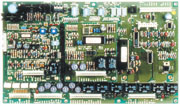
They are also offering comprehensive solutions for contractors who specialize in retrofitting controls systems in older buildings. This is a special hvac challenge. According to commercial contractors and engineers, buildings constructed in the 1970s and 80s — and those older buildings that had early digital systems retrofitted over pneumatics — may now have a hodgepodge of what was once state-of-the-art climate control systems.
Some unitary-commercial equipment manufacturers are providing contractors control solutions that are optimally applied to their own equipment, but that can also be applied to other hvac brands. The Lennox L Connection Network, for instance, is a commercial control system that offers remote monitoring, diagnostics, system setup, and alarm reset.
It operates optimally with the company’s L Series packaged rooftop units; each L Series unit has an Integrated Modular Control (IMC) standard. However, the IMC can be installed on other manufacturers’ equipment.
This system operates through the manufacturer’s network thermostat control, control panel, and software. “This allows you to control a mix of products in your building through one control
system,” the company says. The thermostat has a two-heat/three-cool capacity, along with fused switches for testing installation and setup.

CALIFORNIA CONTRACTOR
In 2001, Kinetics Mechanical Services, a San Francisco Bay-area contractor, was awarded a service contract with Facilities West, a building management company, for Greater Bay Banks.While assessing the hvac system for the main headquarters bank in San Francisco (nicknamed “Old Ironsides” by Kinetics for its location on Old Ironsides Rd.), Kinetics determined that the system was very old and inefficient; the contractor recommended replacement. Like those in many older buildings, this building’s previous hvac system had several setback thermostat controllers, which made climate control hectic and inefficient at times.
According to Monte Brotnov, commercial territory manager for Lennox, “There were many different generations of control products in these buildings. Some had time clocks in various stages of disrepair. Some had setback thermostats. The bank needed a more central, energy-efficient direct digital control system.”
“Monte…showed us the L Connection product last year,” said Jim O’Rourke, former Kinetics operations and labor manager. “It looked very economical and labor efficient.”
Kinetics recommended a network of 16 L Series rooftop units and one Lennox split-system unit, all wired to the system’s Network Control Panel (NCP). According to the manufacturer, up to 31 hvac units can be tied to one NCP for central monitoring.
The control panel features time-of-day scheduling, current zone temperature, supply and return temperature, date- and time-stamped Integrated Modular Control (IMC) alarm codes, and more from one central panel, or from remote locations using the system’s software.
According to Lennox, “The IMC is a combination rooftop and ddc that diagnoses problems through an illuminated numeric code. When monitored via the NCP, the IMC code not only pinpoints the trouble, but also gives a diagnostic history. The NCP, used with the IMC, also displays the time and date the problem occurred.”
Contractors can wire multiple units to a central NCP, which can be monitored onsite or remotely via a modem and a computer with NCP software installed.

MARKET CHANGES
At the time (late 2000-early 01), Kinetics also decided on this system because of the service contract potential with Facilities West. There was a possibility of service and renovation work for 50 to 80 more Greater Bay Banks’ hvac systems.According to Brotnov, this has not come to pass yet due to economic changes that have taken place between then and now.
“Kinetics has not yet received more work from Greater Bay Banks,” he said, “because around that area [San Francisco-Silicon Valley], work has dried up. There’s a lot of space available.”
However, the contractor had already generated a lot of quotes for the expansion of the project. In addition, since the company performs maintenance for Greater Bay’s Old Ironsides branch, Kinetics already has a foot in the door, so to speak.
O’Rourke and Kinetics salesman Tony Rinchack had planned on the ability to eventually place NCP panels in most of the banks and remotely monitor and control all of the hvac systems from their PCs. This will give Facilities West and Greater Bay Banks a big advantage in maintaining equipment and increasing customer satisfaction. According to Brotnov, “If there’s a problem, it can be diagnosed from Kinetics’ office — parts can be pulled and taken to the jobsite,” so technicians don’t have to run back and forth.
They can arrive at the jobsite knowing outdoor, supply and return temperatures, lockout conditions, and prior fault codes. Techs can mull over this information while driving to the site.
The system has been tested with a real-world problem. Shortly after the building opened last August, according to Brotnov, one zone wasn’t heating up fast enough. The system was used to quickly troubleshoot the problem. The procedure ran according to plan.
In addition, the reset function sometimes can buy a contractor a little time. “Many times after accessing the panel, we can just reset the unit remotely from the PC instead of sending a service technician out to the site immediately,” said O’Rourke. “Then, after we’ve reset the unit and assessed a problem, we will send a technician out to the site.”
What did Brotnov learn from the application? “It was the first L Connection job I sold and was involved with,” he said. “It demonstrated that the system really does work. This thing was plug and play. It was surprising how well it worked.”
Later this year, the control system will be tested in Reno, NV, with another brand of air conditioning equipment.
Publication date: 03/25/2002

Report Abusive Comment